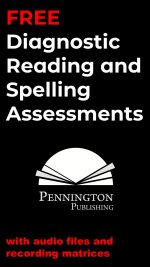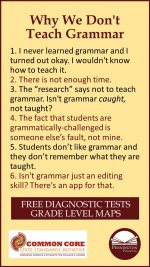Research-Based Spelling Worksheets
Years ago at the height of the whole language movement in California, a fourth grade teacher began his first year of teaching. Committed to teaching to the individual needs of his students, he consulted his mom for advice. Mom had recently retired after teaching 35 years as an intermediate and upper elementary teacher. She also had waded into the middle school environment for a few years before settling down in fifth grade for the last ten years of her career. Mom suggested that he assess his students and then assign targeted worksheets to address specific deficits indicated by the assessments. Her son had never heard this in his experiential learning teacher training program. He knew how to do role plays and simulations, but not much about teaching (even in his methods classes).
Mom climbed up into the attic and brought down her neatly packed boxes of teaching files. She dug out hundreds of grammar, spelling, vocabulary, and reading worksheets for her son to check out.
The rookie teacher was overwhelmed at the treasure trove of resources. Most of the worksheets fit the fourth grade age level and were quite good. As a veteran teacher, mom had carefully weeded out the “drill and kill” worksheets and had saved the ones that students learned from best. Every worksheet had been field tested and had Mom’s seal of approval. Some of the worksheets were from educational publishers long out of business or bought up by huge educational syndicates, but most of the worksheets were Mom’s own–no doubt revisions of store-bought products. Half of these worksheets were on old mimeograph (ditto) paper (Remember the smell?) Half of them were word processed documents after the advent of cheaper school copiers and duplo machines.
Mom warned her son not to share the worksheets with colleagues. No, she wasn’t worried about the copyright infringements; she was worried that her untenured son would be accused of not solely teaching the district adopted curriculum. She had heard that State Superintendent of Schools, Bill Honig, had removed workbooks from the approved supplemental resource list and was even reported as telling principals to confiscate any spelling workbooks at school sites. Those were the early days of the National Writing Project in which spelling (and punctuation, grammar, and word choice) were relegated to the editing-only stage of the writing process. Teachers regularly told students not to worry about spelling (or anything smacking of language conventions) during the rough draft stage of their writing because they could “clean up” the language for their final draft. If they chose to complete final drafts.
What Happened to Spelling Test Scores?
Of course spelling, grammar, usage, mechanics, and vocabulary scores plummeted during the late 1980s and early 1990s, sparking yet another “Back to Basics” movement. Mom had warned her son about the cyclical nature of educational movements and philosophies. “Been there; done that,” said Mom. “Remember that your first priority is to your students. You will learn what works best. But don’t be dumb. Wait until you’re tenured to share any of these worksheets with your colleagues. They’ll want them… even the ones that have said otherwise.”
In his fourth grade classroom the new teacher faithfully taught the district adopted curriculum, but he found time to “sneak in” worksheets targeted to individual assessment-based skills and concepts deficits. Students completed assigned worksheets, self-corrected and self-edited any errors from the Answer Book, and brought up the graded worksheet to their teacher for review. Each worksheet had a short test (a formative assessment) to see if the student had mastered the focus skill or concept. The test was a short written application to see if the student understood and could use what was learned correctly. Most of the time the student successfully masted the skill. Students loved completing the worksheets and placing the gold star next to their name on the wall poster.
The spring test results came in shortly after school started back up in September. The principal called in the now second-year teacher and asked him why his test scores were so much higher than those of his grade level team. “I just followed the district-adopted curriculum, and I had great kids,” he replied.
That night he took Mom out to dinner.
The educational research provides insight as to what makes a spelling worksheet an effective instructional strategy for knowledge and/or skills acquisition.
In a January 2016 article, the American Psychological Association published a helpful article titled “Practice for Knowledge Acquisition (Not Drill and Kill)” in which researchers distinguish between deliberate practice and “drill and kill” rote memorization: “Deliberate practice involves attention, rehearsal and repetition and leads to new knowledge or skills that can later be developed into more complex knowledge and skills… (Campitelli & Gobet, 2011).”
“… several conditions that must be in place in order for practice activities to be most effective in moving students closer to skillful performance (Anderson, 2008; Campitelli & Gobet, 2011; Ericsson, Krampe, & Clemens, 1993). Each of these conditions can be met with carefully designed instruction.”
- Teachers should design practice tasks with students existing knowledge in mind. The Spelling Pattern Worksheets are assigned according to the results of the Diagnostic Spelling Assessment (the link connects to the eight grade assessment). Each of the grades 4-8 assessments includes an audio file to make administration simple (great for make-ups as well). Here’s a link to the eighth grade audio file and to the recording matrix for progress monitoring. These whole class assessments perfectly correspond with the targeted worksheets so that students complete only those grade level spelling patterns which students have not yet mastered. When students succeed at practice problems, the benefits of practice are maximized. But when students become frustrated with unrealistic or poorly designed practice problems, they often lose motivation, will not receive the full benefits of the practice they have done, and will be less motivated to attempt future practice problems. Students are motivated to practice by mastering each unmastered concept or skill, marked with an “/” on the data matrix. Once a student has mastered a worksheet, points are assigned and the teacher (or student) changes the unmastered “/” into a mastered “X” on the data matrix. Yes, gold stars work, too!
- Provide clear instructions on performance expectations and criteria. Guide students through sample practice problems by using prompts that help them reflect on problem-solving strategies. Break complex problems into their constituent elements, and have students practice on these smaller elements before asking them to solve complex problems independently. Directions are concisely and clearly written so that students can complete the worksheets independently. Each worksheet has been field tested in grades 4-8 classrooms and revised to ensure student success. The applicable spelling rules and examples are provided before the practice section on every worksheet.
- Provide students with fully completed sample problems as well as partially completed sample problems before asking them to apply new problem-solving strategies on their own. The Spelling Pattern Worksheets provide samples (examples) of each focus spelling pattern.
- Students should have repeated opportunities to practice a task through practicing other tasks like it. Students complete a spelling sort to apply the focus spelling pattern. The practice section also includes rhyme, word search, and word jumble activities.
- Students receive the greatest benefits from practice when teachers provide them with timely and descriptive feedback. Students complete the spelling sort and practice section and self-correct and self-edit from the Answers Booklet to gain immediate feedback and learn from their own mistakes.
- Provide plenty of opportunities for students to practice applying problem-solving skills before you test them on their ability to use those skills. Next, students complete a short formative assessment (a brief written application of the focused spelling patterns) at the bottom of each worksheet and bring up the completed worksheet to the teacher for a mini-conference. The teacher evaluates the formative assessment to determine mastery and quickly checks the practice section to make sure that the student has completed and self-corrected. If mastered, the teacher (or student) changes the unmastered “/” into a mastered “X” on the data matrix. If unmastered, the teacher briefly re-teaches and the student completes the formative assessment once more.
- Distribute practice over extended periods of time. Students work at their own pace, completing the Spelling Pattern Worksheets. The teacher provides points for each mastered worksheet.
A Model Grades 3-8 Spelling Scope and Sequence
Preview the Grades 3-8 Spelling Scope and Sequence tied to the author’s comprehensive grades 3-8 Language Strand programs. The instructional scope and sequence includes grammar, usage, mechanics, spelling, and vocabulary. Teachers and district personnel are authorized to print and share this planning tool, with proper credit and/or citation. Why reinvent the wheel? Also check out my articles on Grammar Scope and Sequence, Mechanics Scope and Sequence, and Vocabulary Scope and Sequence.
FREE DOWNLOAD TO ASSESS THE QUALITY OF PENNINGTON PUBLISHING AMERICAN ENGLISH AND CANADIAN ENGLISH SPELLING PROGRAMS. Check out these grades 3-8 programs HERE. Administer my FREE comprehensive Diagnostic Spelling Assessment with audio file and recording matrix. It has 102 words (I did say comprehensive) and covers all common spelling patterns and conventional spelling rules. It only takes 22 minutes and includes an audio file with test administration instructions. Once you see the gaps in your students’ spelling patterns, you’re going to want to fill those gaps.
Get the Diagnostic Spelling Assessment, Mastery Matrix, and Sample Lessons FREE Resource:
![]()









